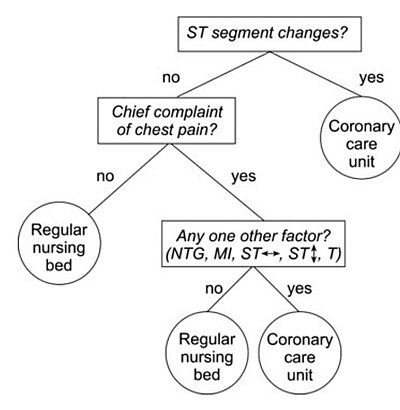Fast-and-frugal trees
In artificial intelligence and in heuristic decision-making, a fast-and-frugal tree is a type of classification tree. Fast-and-frugal trees can be used as decision-making tools which operate as lexicographic classifiers, and, if required, associate an action (decision) to each class or category.[1] The original fast-and-frugal trees introduced in 2003 by Laura Martignon, et al. are simple both in execution and in construction, and constitute a kind of simple heuristic in the adaptive toolbox postulated by Gerd Gigerenzer and the Center for Adaptive Behavior and Cognition.[1] Similar models had been previously used by Martignon & Hoffrage, 1999; Green and Mehr, 1997 [GM]; Dhami and Ayton, 2001 [DA]; Dhami and Harries, 2001 [DH] and Fischer, Steiner, Zucol, Berger, Martignon, et al. 2002 [FZBM].
Yet recent developments in several fields of application have maintained the simplicity in execution, introducing subtle, relevant procedures for construction that have proven extremely useful for users.[2]
How a fast-and-frugal tree works
The basic elements on which to ground a binary classification are (sets of) cues. The fast-and-frugal tree establishes a ranking and, according to the ranking, a “topology” of the tree. Once the ranking is established, the fast-and-frugal tree checks one cue at a time, and at each step, one of the possible outcomes of the considered cue is an exit node which allows for a decision.
Fast-and-frugal trees can also be described in terms of their building blocks. First, they have a search rule: They inspect cues in a specific order. Second, they have a stopping rule: Each cue has one value that leads to an exit node and hence to a classification, and another value that leads to consulting the next cue in the cue hierarchy (the exception being the last cue in the hierarchy, which has two exit nodes). Finally, they have a classification rule.

Figure 1 illustrates a fast-and-frugal tree for classifying a patient as “high risk” of having a heart stroke and thus having to be sent to the “coronary care unit” or “low risk” and thus having to be sent to a “regular nursing bed [GM] (Green& Mehr, 1997). Fast-and-frugal trees have been characterized mathematically as lexicographic classifiers (Martignon, Katsikopoulos and Woike, 2008) and as linear classifiers with non-compensatory weights (Martignon, Katsikopoulos and Woike, 2008) [MKW]. Their “topology” and construction has been analysed using signal detection theory (Luan, Schooler and Gigerenzer, 2011) [LSG] and their performance and robustness when compared to regression and CARts has been studied by Laskey and Martignon (2014)[LM]. An extensive study on the robustness, the predictive value and sensitivity/specificity of Fast-And-Frugal trees compared to those of Naive Bayes and of Full Natural Frequency Trees has been carried out by[WHM].
In 2017, Phillips, Neth, Woike and Gaissmaier [PNWG] introduced the R package FFTrees, which uses new algorithms to construct and evaluate FFTs. A simulation study across ten real-world data sets shows that FFTs created by FFTrees can predict data as well as more complex classification algorithms, while remaining simple enough for anyone to understand and use.
Related Articles and other Sources
| GM. | Green and Mehr, 1997 Green, L., & Mehr, D. R. (1997). What alters physicians’ decisions to admit to the coronary care unit? The Journal of Family Practice, 45(3), 219–226.
|
| DA. | Dhami, M. K., & Ayton, P. 2001. Bailing and jailing the fast and frugal way. Journal of Behavioral Decision Making, 14(2), 141-168.
|
| DH. | Dhami and Harries, 2001 Fast and frugal versus regression models of human judgement. Thinking & Reasoning, 7(1), 5-27.
|
| FZBM. | Fischer, Steiner, Zucol, Berger, Martignon Use of simple heuristics to target macrolide prescription in children with community-acquired pneumonia. Archives of Pediatrics & Adolescent Medicine, 156(10), 1005-1008.
|
| MKW. | Martignon, Katsikopoulos & Woike 2008 Categorization with Limited Resources: A Family of Simple Heuristics
|
| LSG. | Luan, Schooler and Gigerenzer, 2011 A signal-detection analysis of fast-and-frugal trees.
|
| LM. | Laskey and Martignon, 2014 Comparing fast-and-frugal trees and bayesian networks for risk-assessment.
|
| WHM. | Woike, Hoffrage & Martignon, 2017 – Integrating and testing Natural Frequencies, naive Bayes and Fast-and-Frugal Trees.
|
| PNWG. | Phillips, Neth, Woike, & Gaissmaier, 2017. FFTrees: A toolbox to create, visualize, and evaluate fast-and-frugal decision trees. Judgment and Decision Making, 12 (4), 344–368.
|
References
- ^ a b Martignon, Laura; Vitouch, Oliver; Takezawa, Masanori; Forster, Malcolm. "Naive and Yet Enlightened: From Natural Frequencies to Fast and Frugal Decision Trees", published in Thinking : Psychological perspectives on reasoning, judgement and decision making (David Hardman and Laura Macchi; editors), Chichester: John Wiley & Sons, 2003.
- ^ Luan, Sheng Hua, Schooler, Lael & Gigerenzer Gerd Psychol Rev. 2011 Apr;118(2):316-38. doi: 10.1037/a0022684. A signal-detection analysis of fast-and-frugal trees. Luan, S.; Schooler, LJ; Gigerenzer, G.
